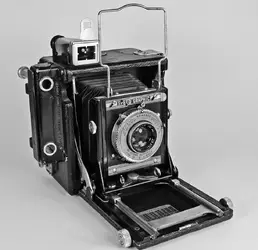First let's eliminate LF.
LF is a PiA to deal with, especially for a beginner.
Just the film, you have to learn how to load the film holder, then unload the film holder, then package the film for shipping to a processor. All this in a darkroom or changing bag.
If you send out film for processing, then 35mm or MF.
However, for a given cost of film and processing, 35mm gets you more shots than MF.
This can be/is a significant advantage to a newbie. I can afford to "try" something new, and "waste" a shot if it does not work.
If you DiY B&W film processing.
- It is cheaper to process 35mm than MF. Two rolls of 35mm 36 exposure film (total 72 frames) uses the same amount of chemicals as ONE roll of MF film with only 12 frames (120 film, 6x6 frames).
- While a 6x6 enlarger is not too hard to find, finding a MF enlarger larger than 6x6 is significantly more difficult.
- If you have to make it a temporary darkroom, where you have to break down and store the enlarger every time, it is a lot easier to setup a temporary 35mm darkroom than a temporary MF darkroom. This is basically due to the larger size/bulk of the MF enlarger.
If you use contact sheets, a MF contact sheet is easier to use than a 35mm contact, simply because the frame (and image) size is larger.
BUT, IMHO as other have said, for a newbie,
it comes down to the feedback cycle.
Digital gives essentially instant feedback. Did you get the shot or not? Just look at the screen on the back of the camera.
Shoot a roll of, and you should plan of it taking up to TWO WEEKS before you get it back from the lab; mail out, process, mail back. How do you learn when the feedback of your performance takes two weeks to happen? Most people can't remember what they did two weeks ago. What did you do that one shot is better than another?
When one is learning, the FAST feedback is tremendously important, especially for correcting mistakes.
FAST feedback is also important in holding attention.
Gee the shot of that flower is good, let me try shooting another flower . . .
BTW, Polaroid backs for most MF and LF cameras is a thing of the past. So no instant feedback.
The Impossible Project is not there, from what I've seen.



 And what of the digital back, sometimes making something bigger (like a sensor) doesn't work as well.
And what of the digital back, sometimes making something bigger (like a sensor) doesn't work as well.
![[No title]](/data/xfmg/thumbnail/37/37100-48f2853fd9bcaf95edec62ff0be19ad3.jpg?1734169828)



![[No title]](/data/xfmg/thumbnail/37/37103-871e5d39d6f585e3019a4e25eb2ee935.jpg?1734169829)






